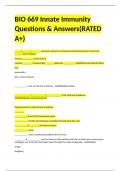BIO 669 Innate Immunity
Questions & Answers(RATED
A+)
______/_______/_________ immunity: physical, mechanical, biochemical barriers. This is the
_______ line of defense
Prevent __________ from bacteria
Includes ________, chemicals like _______, defensins, _________ - ANSWERInnate/Natural/Native
first
penetration
skin, sweat, lysozyme
___________ is the second line of defense - ANSWERinflammation
______________/_____________/_____________ is the third line of defense -
ANSWERAdaptive/acquired/specific
Physical barriers in the first line of defense:
________-
___________ of the GI/GU/respiratory tracts
____________ of cells, the pathogen is sloughed off with dead skin cells
___________ &_________ eliminates irritants
____________-urine
____________-clear out potential problems from GI tract
__________& ___________- used in airway to trap particles and cilia can help move mucous up to
esophagus, put in GI tract and broken down through the action of digestion - ANSWERskin
linings
sloughing
,sneezing and coughing
flushing
vomiting
cilia and mucous
1st line of defense includes the ________ cell (same as below)
Saliva, earwax, tears, sweat and mucous are all secreted by the _____________ cell. Antimicrobial
peptides: cathelicidins, definsins, collectins, mannose-binding lectin - ANSWERepithelial
The 1st line of defense also includes: A normal ___________ includes each surface being colonized
by bacteria and fungi that is unique to the particular location and individual. - ANSWERmicrobiome
The 2nd line of defense: ___________ response. It is the _______ immune response to an injury.
It is specific/nonspecific, caused by a variety of materials:
____________, tissue necrosis, trauma, injury, foreign bodies, immune reaction, ischemia, etc.
Local S&S:
redness-___________, heat-____________, swelling-___________-, pain, loss of function -
ANSWERinflammatory response
first
infection
rubor-redness, callor-heat, swelling-tumor
2nd line of defense: The inflammatory response includes
1. Blood vessel ___________-
2. Increased/Decreased vascular ___________ & ____________-
3. WBC __________ to the inner walls of the vessels and __________ through the vessels -
ANSWERdilation
Increased vascular permeability & leakage
adhere, migrate
The vascular response of blood vessel dilation is brought on by ______________, serotonin, and
__________ that all increase vascular ____________-, decrease linkage between cells, allow for
pericellular movement, allow for leakage of fluid and proteins into the __________ from the
, ___________, increasing fluid movement into the __________, bringing _____ & _________, inc bf,
inc redness to area which serves the purpose of improving temperature for enzyme function, for
healing, fighting pathogens, diluting toxins, increasing ___________ to the area, increasing
____________ __________ to allow for potential id of these pathogens. - ANSWERhistamines,
bradykinin, permeability
tissues
vasculature
tissues
heat
swelling
oxygen
lymphatic drainage
goals of inflammation (2nd immune response)
-Prevent & limit further damage
-Initiate the _________ immune response: produce more _______, draw WBCs to area, increase cell
__________ molecules that bring WBCs in
-Initiate healing by bringing in _____________ that engulf damaged tissue and allow for initiation of
new blood vessels to try and bring in __________ for the healing process
- Limit and control the inflammatory process
The ___________ immune response can release mediators to help turn down immune response
Inflammation causes _____________- small vessels will clot off to wall of the damaged area and
prevent it from growing if possible. - ANSWERadaptive, WBC
adhesion
macrophages
oxygen
adaptive
hypercoagulability
plasma protein systems - ANSWERComplement system
Clotting system
Kinin system




